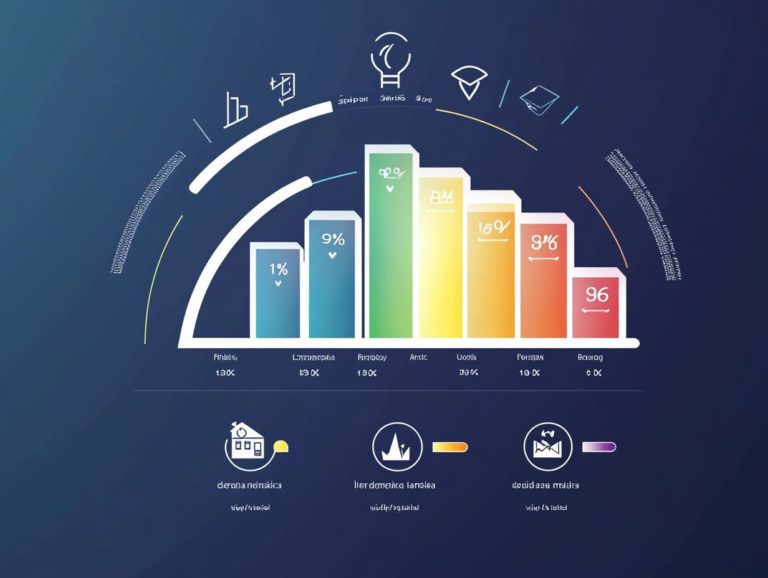Peer-to-Peer Lending: How to Get Started
Peer-to-peer lending is revolutionizing the landscape of borrowing and investing, providing a direct link between borrowers and individual investors.
This model invites you to delve into its mechanics, advantages, and possible challenges. Whether you’re a borrower in search of funding or an investor eager to uncover new opportunities, grasping the process is crucial.
Equipped with practical tips for success, you will confidently navigate the world of peer-to-peer lending, opening the door to a new realm of financial possibilities.
Contents
Key Takeaways:

Consider both the benefits and risks before participating in peer-to-peer lending. It can be a great opportunity for borrowers and investors, but it’s important to do your research and understand the potential risks.
Before getting started, make sure to thoroughly research the peer-to-peer lending platform and the borrowers/investors you’ll be working with. This helps create a successful experience for everyone!
Be aware of best practices for success in peer-to-peer lending, such as diversifying your investments and maintaining good credit as a borrower. With proper preparation, peer-to-peer lending can be a beneficial and lucrative option for both borrowers and investors.
What is Peer-to-Peer Lending?
Peer-to-Peer (P2P) lending represents a groundbreaking financial concept that connects you directly with investors, removing the need for traditional middlemen like banks or lenders. This approach gives you the power to secure personal loans and different types of financial support tailored to your specific needs.
Unlike credit unions or conventional institutions, P2P lending platforms such as LendingClub and Prosper harness digital technologies to efficiently manage a marketplace for loans.
The concept of P2P lending emerged in the early 2000s, driven by a desire for more accessible financing alternatives for individuals and small businesses. Unlike the traditional lending landscape, where you often find yourself tangled in a complex web of paperwork and stringent requirements, P2P lending simplifies the process, making it user-friendly and efficient.
Today, platforms like LendingClub and Prosper are at the forefront of this peer-based ecosystem. They allow you to apply for personal loans online, set competitive interest rates, and diversify your investment portfolio all while challenging the status quo of established financial institutions.
How Peer-to-Peer Lending Works
Understanding how Peer-to-Peer lending operates is crucial for you as both a borrower and an investor aiming to navigate this innovative financing landscape.
You start with an online application where you outline your loan preferences types, desired amount, interest rate, and loan term. Each of these details plays a vital role in aligning you with suitable investors.
This efficient application process not only enhances your access to funding but also gives investors the power to explore loan listings that resonate with their investment goals.
Step-by-Step Process
The step-by-step journey of Peer-to-Peer lending begins with you assessing your borrowing needs. Determine the funding options that best suit your circumstances. It’s essential to take a close look at your credit score, as it plays a pivotal role in the risk assessment performed by the lending platform, ultimately influencing the loan offers you receive. For a deeper understanding, check out this beginner’s guide to peer-to-peer lending.
After clarifying your requirements, you typically create a comprehensive profile that outlines your financial history and the purpose behind your loan request. This initial application undergoes review by the lending platform, which conducts a thorough risk assessment to evaluate your creditworthiness.
Your credit score, often reflective of your past borrowing habits, significantly impacts the terms presented to you, including interest rates and loan amounts. Generally, higher credit scores pave the way for more favorable terms, while lower scores might lead to steeper interest rates.
Following this assessment and approval process, the platform matches you with potential investors, culminating in the finalization and funding of your loan.
Ready to dive into peer-to-peer lending? The opportunities await!
Benefits of Peer-to-Peer Lending
Peer-to-peer lending can be a game-changer for your finances! Imagine accessing funds quickly and easily. It presents a wealth of advantages for both borrowers and investors, establishing itself as an appealing alternative financing option in today s dynamic financial landscape.
For borrowers, P2P lending opens the door to personal loans that often come with lower interest rates and more lenient credit requirements than traditional lenders. This accessibility allows you to pursue your financial goals with greater efficiency.
For investors, the opportunity to earn substantial returns through different ways to invest in a marketplace lending environment offers unique pathways for growth and wealth accumulation.
For Borrowers

For you as a borrower, Peer-to-Peer lending meets crucial funding needs by offering personalized loan amounts designed specifically for your circumstances, often with more lenient credit requirements than traditional methods. This flexibility lets you secure financing for many purposes.
You can consolidate credit card debt, finance home equity loans, or tackle other personal financial goals. You may find that P2P lending offers lower interest rates compared to what banks typically offer, making it a more cost-effective solution.
The application process is generally straightforward, providing you with quick access to funds without the usual headaches associated with traditional lending institutions.
You have the power to choose your loan amounts, perfectly tailored to your specific needs, allowing you to take control of your financial decisions with greater ease and confidence.
For Investors
As an investor in Peer-to-Peer lending, you must be ready to tackle various risks head-on. You have access to a diverse array of investment opportunities that allow you to strategically allocate your capital according to your individual preferences and risk tolerance.
You can diversify your portfolio by selecting loan listings that align with your investment strategies, potentially achieving impressive returns while remaining well-informed about the various risks involved.
This innovative lending model gives you the power to assess different risk factors associated with each loan, including borrower credit scores (a number that represents your creditworthiness) and repayment histories.
By thoughtfully evaluating these elements, you can tailor your investments to match your comfort level and optimize your yields. The ability to filter loans by criteria such as interest rates or loan purposes further enables you to customize your approach, ensuring that your capital works diligently for you in this dynamic marketplace.
Risks and Considerations
While Peer-to-Peer lending offers a range of enticing benefits, it’s crucial for you to grasp the potential risks that both borrowers and investors face, alongside the necessity for robust risk management strategies.
As an investor, you’ll need to deal with different risks such as borrower defaults and regulatory oversight. On the flip side, if you’re a borrower, it s vital to familiarize yourself with your credit requirements and the specific loan terms to steer clear of any possible pitfalls.
Potential Risks for Borrowers and Investors
In the realm of Peer-to-Peer lending, you ll encounter potential risks primarily linked to your credit score and the terms of your loans. If not managed with care, this can lead to higher monthly payments that may strain your budget.
On the flip side, as an investor, you face borrower risks that can impact your expected returns, including the risk of defaults and the variability of loan terms.
Your credit score is pivotal in determining the interest rates for your loans; a lower score often means less favorable terms, complicating your repayment journey.
For investors, the stakes are equally high. They depend on the stability and reliability of borrowers to achieve consistent returns. When borrowers have poor credit profiles, the risk of defaults increases, ultimately eating into the investors anticipated profits.
Grasping these dynamics is crucial for both borrowers and investors, as it highlights the interconnected nature of lending and investing in the Peer-to-Peer landscape.
Factors to Consider Before Participating
Before diving into Peer-to-Peer lending, which allows individuals to lend money directly to others, bypassing traditional banks, it’s important to evaluate several critical factors. These include your choice of lending platform and understanding the risks of peer-to-peer lending and how much risk you are comfortable taking.
If you re a borrower, understanding your own profile and financial needs is essential. Think about your income stability and credit history!
For investors, crafting a sound investment strategy based on the loans you re considering is key. Examining the reputation of various lending platforms is also crucial for ensuring a secure experience.
You should research user reviews, check for regulatory compliance, and look into the platform s track record in handling defaults. As a prospective borrower, take a moment to reflect on your personal financial circumstances.
Meanwhile, investors should also stay informed about current market trends, including interest rates and economic conditions. By carefully assessing these elements, you can navigate the complexities of P2P lending more effectively.
This ultimately enhances your chances of achieving successful outcomes.
Getting Started with Peer-to-Peer Lending

Embarking on your journey with Peer-to-Peer lending begins with a simple online application process. This unlocks a range of funding options for borrowers and investment opportunities for investors, especially when you grasp understanding the peer-to-peer lending process.
Grasping the initial steps in the loan process is essential for both parties. This enables you to make informed choices that align seamlessly with your financial goals.
Steps to Take
The first step in your journey with peer-to-peer lending is to complete the online application. Here, you’ll provide essential details about your loan listing and the funding you desire.
This grants you access to the options available on the platform and lays the groundwork for loan approval and funding. Once you ve submitted the application, double-check that all information is accurate and complete.
This attention to detail can significantly influence the approval process. Be sure to articulate your financial needs clearly and be ready to discuss your credit history and repayment plans.
To enhance your application, consider providing supplementary documents, such as proof of income or a well-structured budget plan. This showcases your responsibility and can significantly boost your chances of approval.
After your application is reviewed, lenders will evaluate the associated risks based on the information you ve provided and decide on suitable loan offers.
Engaging actively with potential lenders during the loan listing process is vital. Clear communication can lead to more favorable terms and expedite the funding you re seeking.
Tips for Success in Peer-to-Peer Lending
To achieve success in Peer-to-Peer lending, adhere to best practices tailored to your specific needs and financial goals.
If you re a borrower, clarify your borrowing requirements and explore various loan options. This can secure the most favorable terms and profoundly influence your financial outcomes.
If you’re an investor, crafting a robust investment strategy that emphasizes diligent risk management is crucial for navigating the landscape effectively.
Best Practices for Borrowers and Investors
In Peer-to-Peer lending, start by clearly defining your financial goals. To make informed decisions, consider exploring the ethics of peer-to-peer lending as you compare various loan offers and fully understand the terms tied to each option.
As an investor, align your investment preferences with your risk tolerance to maximize your returns.
To expertly navigate this landscape, assess your creditworthiness and select loans that match your repayment capability. This helps avoid any financial overextension.
For investors, diversifying your portfolio by spreading your investments across different loan grades can significantly mitigate risk.
By taking these thoughtful steps, you and other participants in this lending ecosystem can foster a more harmonious environment. This ultimately enhances financial stability and satisfaction for everyone involved.
Frequently Asked Questions
What is peer-to-peer lending?

Peer-to-peer lending allows people to borrow and lend money directly. This process happens online, connecting borrowers with investors without a bank’s help.
How does peer-to-peer lending work?
Borrowers create a profile on an online platform and apply for a loan. Investors can fund the loan fully or partially. Borrowers then repay the loan with interest over time.
What are the benefits of peer-to-peer lending?
Borrowers often enjoy lower interest rates and flexible terms. Investors can earn better returns compared to traditional savings accounts.
How do I get started with peer-to-peer lending?
Start by finding a trustworthy online platform. Create a profile to browse loans that match your investment goals, or apply for a loan if you need money.
Is peer-to-peer lending safe?
Like all investing, peer-to-peer lending has risks. Most platforms conduct credit checks on borrowers and offer options to diversify investments to reduce these risks.
What fees are involved with peer-to-peer lending?
Fees vary by platform and loan type. Borrowers may face an origination fee, which is an upfront charge for processing the loan. Investors might pay service fees or a percentage of earnings. Always read the terms and fees before joining a platform.






